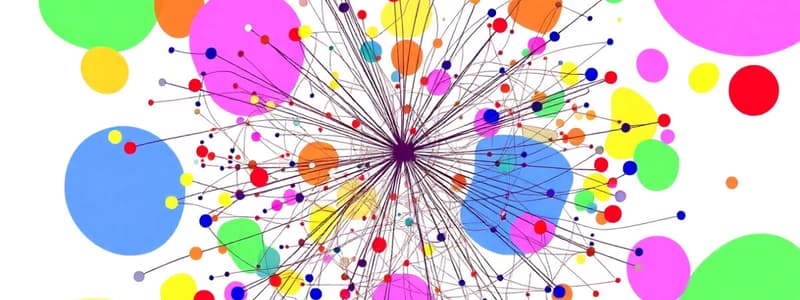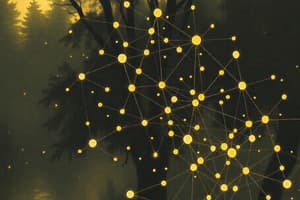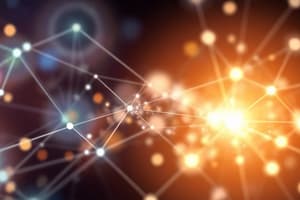Podcast
Questions and Answers
Two actors are connected if they played in the same ______.
Two actors are connected if they played in the same ______.
movie
In a protein network, two proteins are connected if an experimental ______ existed.
In a protein network, two proteins are connected if an experimental ______ existed.
evidence
The nodes and edges are the building blocks of a ______.
The nodes and edges are the building blocks of a ______.
graph
In a network, the links can be either directed or ______.
In a network, the links can be either directed or ______.
Social networks composed of symmetric ties are represented using ______ graphs.
Social networks composed of symmetric ties are represented using ______ graphs.
Networks with asymmetric ties are represented using a ______ graph.
Networks with asymmetric ties are represented using a ______ graph.
The choice of network ______ can affect our understanding of its structure.
The choice of network ______ can affect our understanding of its structure.
The way you assign links will determine the nature of the ______ you can study.
The way you assign links will determine the nature of the ______ you can study.
You are likely enrolled in a social network’s ______ if you are reading this.
You are likely enrolled in a social network’s ______ if you are reading this.
The term '______' implies a relationship type, distinct from the term 'friend.'
The term '______' implies a relationship type, distinct from the term 'friend.'
It is important to define a ______ to effectively map social relationships.
It is important to define a ______ to effectively map social relationships.
Networks are often seen as a collection of objects connected by ______.
Networks are often seen as a collection of objects connected by ______.
A ______ is a mathematical representation of a network.
A ______ is a mathematical representation of a network.
The World Wide Web (WWW) is a network of web ______ linked by URLs.
The World Wide Web (WWW) is a network of web ______ linked by URLs.
Metabolic networks in biology reflect a network of chemical ______ that take place in a cell.
Metabolic networks in biology reflect a network of chemical ______ that take place in a cell.
A social graph, as used by platforms like Facebook, visually represents social ______ among users.
A social graph, as used by platforms like Facebook, visually represents social ______ among users.
In a symmetric relationship between two nodes A and B, there exists a single ______ linking them.
In a symmetric relationship between two nodes A and B, there exists a single ______ linking them.
A network is called ______ if all of its links are directed.
A network is called ______ if all of its links are directed.
A directed graph G consists of a set of vertices V and a set E of ______ that are ordered pairs of elements in V.
A directed graph G consists of a set of vertices V and a set E of ______ that are ordered pairs of elements in V.
An edge e is a ______ if it connects a vertex to itself.
An edge e is a ______ if it connects a vertex to itself.
In a directed graph, for every edge, there is a source node and a ______ node.
In a directed graph, for every edge, there is a source node and a ______ node.
In the advice network example, C seeks advice from E, indicating a directed edge from C to ______.
In the advice network example, C seeks advice from E, indicating a directed edge from C to ______.
The case of 'A likes B' shows that A is the source node while B is the ______ node.
The case of 'A likes B' shows that A is the source node while B is the ______ node.
The links of a network can be either ______ or weighted.
The links of a network can be either ______ or weighted.
Sociologists began using mathematical techniques from graph theory in the ______ to study relationships.
Sociologists began using mathematical techniques from graph theory in the ______ to study relationships.
Social networks composed of symmetric, reciprocal ties are called ______ networks.
Social networks composed of symmetric, reciprocal ties are called ______ networks.
The Zachary karate club network study was one of the first data collection projects in the history of ______.
The Zachary karate club network study was one of the first data collection projects in the history of ______.
Social network analysis involves understanding how networks ______ and what they do to people.
Social network analysis involves understanding how networks ______ and what they do to people.
A network is undirected if all of its links are ______.
A network is undirected if all of its links are ______.
Examples of systems with undirected links include ______ on Facebook.
Examples of systems with undirected links include ______ on Facebook.
Two branches of mathematics utilized in social network analysis are graph theory and ______.
Two branches of mathematics utilized in social network analysis are graph theory and ______.
Transmission lines allow electric current to flow in both ______.
Transmission lines allow electric current to flow in both ______.
Social network analysis connects concepts such as roles, ______, and prestige to empirical evidence.
Social network analysis connects concepts such as roles, ______, and prestige to empirical evidence.
A simple graph consists of a nonempty set of vertices and a set of unordered pairs called ______.
A simple graph consists of a nonempty set of vertices and a set of unordered pairs called ______.
Qualitative observational strategies include interviews, while statistical strategies are based on social ______.
Qualitative observational strategies include interviews, while statistical strategies are based on social ______.
Graph representation is crucial for transforming relationships into ______.
Graph representation is crucial for transforming relationships into ______.
An edge is a loop if it consists of the same ______ in the pair.
An edge is a loop if it consists of the same ______ in the pair.
One broad aspect of social network analysis is Network ______.
One broad aspect of social network analysis is Network ______.
Examples of systems with directed links include following on ______.
Examples of systems with directed links include following on ______.
In an undirected graph, it would be nonsensical for person A to claim they spend time with person B and for B to say they ______ spend time with A.
In an undirected graph, it would be nonsensical for person A to claim they spend time with person B and for B to say they ______ spend time with A.
Social Network Analysis (SNA) uses ______ techniques to study social structure.
Social Network Analysis (SNA) uses ______ techniques to study social structure.
Mathematics allows us to give a precise representation of fuzzy social science concepts like 'popularity' or 'social ______'.
Mathematics allows us to give a precise representation of fuzzy social science concepts like 'popularity' or 'social ______'.
Analyzing a social network starts with defining a ______.
Analyzing a social network starts with defining a ______.
Bounding refers to drawing ______ about what will or will not be included in the study.
Bounding refers to drawing ______ about what will or will not be included in the study.
A relationship is a connection between at least two social ______.
A relationship is a connection between at least two social ______.
Networks are not given to us; they have to be ______.
Networks are not given to us; they have to be ______.
In SNA, ______ provides a framework for understanding social relationships quantitatively.
In SNA, ______ provides a framework for understanding social relationships quantitatively.
Social Network Analysis helps predict why some people, organizations, or even ______ are successful and others are not.
Social Network Analysis helps predict why some people, organizations, or even ______ are successful and others are not.
Flashcards
Social Network Analysis (SNA)
Social Network Analysis (SNA)
The study of relationships using mathematical techniques like graph theory and matrix algebra.
Network Graph
Network Graph
A visual representation of relationships between entities, where entities are nodes connected by lines.
Network Theory
Network Theory
The study of the structure, function, and evolution of networks.
Graph Representation
Graph Representation
Signup and view all the flashcards
Network
Network
Signup and view all the flashcards
Different Types of Networks
Different Types of Networks
Signup and view all the flashcards
Traditional Sociological Methods
Traditional Sociological Methods
Signup and view all the flashcards
Mathematical Techniques in Social Network Analysis
Mathematical Techniques in Social Network Analysis
Signup and view all the flashcards
Network Density
Network Density
Signup and view all the flashcards
Quantitative Network Analysis
Quantitative Network Analysis
Signup and view all the flashcards
Degree Centrality
Degree Centrality
Signup and view all the flashcards
Structural Holes
Structural Holes
Signup and view all the flashcards
Strength of Ties
Strength of Ties
Signup and view all the flashcards
Constructing a Network
Constructing a Network
Signup and view all the flashcards
Defining a Relationship
Defining a Relationship
Signup and view all the flashcards
Bounding the Context
Bounding the Context
Signup and view all the flashcards
Undirected Network
Undirected Network
Signup and view all the flashcards
Directed Network
Directed Network
Signup and view all the flashcards
Reciprocal Tie
Reciprocal Tie
Signup and view all the flashcards
Non-Reciprocal Tie
Non-Reciprocal Tie
Signup and view all the flashcards
Network Map
Network Map
Signup and view all the flashcards
Undirected Network (Definition)
Undirected Network (Definition)
Signup and view all the flashcards
Graph
Graph
Signup and view all the flashcards
Directed Network (Definition)
Directed Network (Definition)
Signup and view all the flashcards
What is a network?
What is a network?
Signup and view all the flashcards
What are nodes?
What are nodes?
Signup and view all the flashcards
What are edges?
What are edges?
Signup and view all the flashcards
What is an undirected network?
What is an undirected network?
Signup and view all the flashcards
What is a directed network?
What is a directed network?
Signup and view all the flashcards
Why is network representation important?
Why is network representation important?
Signup and view all the flashcards
How does link assignment impact the network?
How does link assignment impact the network?
Signup and view all the flashcards
What are the applications of network analysis?
What are the applications of network analysis?
Signup and view all the flashcards
Social Relationship
Social Relationship
Signup and view all the flashcards
Relationship Type
Relationship Type
Signup and view all the flashcards
Social Graph
Social Graph
Signup and view all the flashcards
Web Graph
Web Graph
Signup and view all the flashcards
Social Network
Social Network
Signup and view all the flashcards
Symmetric Edge
Symmetric Edge
Signup and view all the flashcards
Directed Graph: Mathematical Definition
Directed Graph: Mathematical Definition
Signup and view all the flashcards
Loop
Loop
Signup and view all the flashcards
Simple Graph
Simple Graph
Signup and view all the flashcards
Advice Network
Advice Network
Signup and view all the flashcards
Source and Destination Node
Source and Destination Node
Signup and view all the flashcards
Weighted and Unweighted Links
Weighted and Unweighted Links
Signup and view all the flashcards
Study Notes
Network Representation
- Social network analysis (SNA) has two main aspects: network theory and network measurement
- Network theory is about understanding how networks function and impact individuals. It provides general statements about how people behave within networks and how networks themselves operate.
- Network measurement focuses on quantifying network properties, using mathematics to represent social connections. It links social network concepts to different mathematical methods and uses matrices for quantitative representation.
From Relationships to Graphs
- Sociologists traditionally studied relationships through observation (interviews) and statistical analysis.
- In the 1950s, sociologists started using mathematical methods like graph theory and matrix algebra to create models of social relationships.
- This allowed them to measure concepts like roles, influence, and prestige.
In This Lecture
- Topics covered include:
- From relationships to graphs, SNA taxonomy
- Ways to represent networks
- Graph representation
- Defining a network
- Different types of networks
Defining a Relationship
- Establishing a relationship type is crucial in network analysis as different relationships lead to differing conclusions.
- Relationships can vary, from those between individuals you know (friends, colleagues) to those you may not know personally.
- Clear definition is required to determine the scope of the network analysis.
How to Graph a Network
- Defining the relationship is the first step in outlining a network
- Establishing the context for a network and defining any boundaries, clarifying what will and will not be studied is the next step.
Network or Graph?
- Networks often represent real-world systems such as the web, social networks, and metabolic networks.
- A graph is a mathematical representation of the network.
- Key graph terminology includes: network, node, link, graph, vertex, and edge.
Graph Representation
- A network is a collection of parts (nodes or vertices) connected by interactions (links or edges).
- The components of a network include the objects (nodes), the interactions between them (links), and the overall network itself (graph).
- Graph representation is a fundamental concept for understanding complex systems by representing relationships using mathematical methods.
Determining Graph Structure
- The nodes and edges define the structure of a graph.
- The choice of the representation of a network will determine what questions you can investigate.
Types of Networks
-
Networks can be directed or undirected.
-
Undirected networks represent symmetrical relationships.
-
Directed networks represent asymmetrical relationships.
- Examples of undirected links include collaborations, friendships, and transmission lines.
- Examples of directed links include phone calls, Twitter followings, and URLs.
-
Networks can also be unweighted or weighted:
- Unweighted networks focus on the existence of a relationship.
- Weighted networks consider the intensity or frequency of a relationship to assign a weight.
-
Networks can have self-loops if the same node interacts with itself
-
Networks can be multigraph if multiple links can exist between the same nodes.
Studying That Suits You
Use AI to generate personalized quizzes and flashcards to suit your learning preferences.




